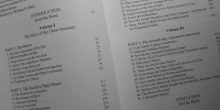What Is Historicism?
Historicism is based on a simple idea: the predictions of the Bible are validated by comparing them to the events of history. If a prophecy is fulfilled, it must be true. Many predictions, like those of Daniel and the Revelation are symbolic. The beast images refer to kingdoms and empires and should obviously not be taken literally. These symbols are, moreover, explained by internal interpreters, so that we need not guess at their meaning. For instance, in the book that bears his name, Daniel told Nebuchadnezzar that the great metal man which the king had seen in his dream represented earthly realms and the stone which smashed it up the Lord’s everlasting kingdom. Other internal interpreters, especially the angel Gabriel, likewise play their role in both Daniel and the Revelation. These books also make use of time symbolism, centered in the year-day principle. That is, a day in prophecy represents a calendar year, which becomes clear from a study of Numbers 14:34 and Ezekiel 4:6.
To oppose Historicism, Satan has raised up three other schools of prophetic interpretation: Preterism, Futurist, and Idealism.
Of these, the last mentioned is the boldest: it denies that the Bible really foretells the future. It is based on the allegorizing methods of third-century theologians like Clement and Origen at Alexandria, Egypt. Their mentors if not their boon companions were mostly pagans, both Platonic and Neo-Platonist. Allegorization, by which anything can be arbitrarily made to mean anything else, mutated into Idealism.
Much of the Great Apostasy in the early Christian period had its roots in the Hellenic and Hellenistic world. Stephen N. Haskell, a Seventh-day Adventist prophetic writer of the nineteenth and early twentieth centuries, touched on this point:
“Through Greece, ‘the prince of the power of the air,’ the ‘old dragon,’ who was cast into the earth, attempted a new scheme for enslaving the truth. Greek culture and intellectual development carried men farther away from the simple truth of God’s Word than any form of religion, or any oppression from the government. The teachers of Greek philosophy followed in the wake of the Alexandrian conquests. The beauty and aesthetic nature of their learning deceived men as nothing else has ever done. The mixture of good and evil was divinely represented by the spotted leopard, and its universal acceptance, by the lithe form and agile movements.” (The Story of the Seer of Patmos, p. 227). If their origins lay further in the past, they were specifically adopted in the framework of the Counter-Reformation, which during the sixteenth and early seventeenth centuries reaffirmed but also reorganized the Roman Church. Amongst its greatest achievements were the creation in 1534 of Ignacio de Loyola’s Jesuit order to defend the papacy; the multi-session Council of Trent (1545-1563), which revitalized Catholicism; and the activity of three powerful writers. All of them were Jesuits, two Spaniards and one Italian. They were the Preterist Luis Alcazar (1554-1613) and Francisco Ribera (1537-1591), whose Futurist commentary on Revelation appeared the year before his death, and his eschatological successor, Cardinal Archbishop Roberto Francesco Romolo Bellarmino (1542-1621).
Though these schools differ, both had and still have the same objective: to nullify the idea of the Protestant reformers that the antichrist foretold in the Bible is the papacy. Preterism and Futurism do, of course, relate prophecy to history. But both of them omit the very long medieval period and even the past five hundred years that followed it.
For more than a hundred years, the largely Historicist Protestants ignored both Preterism and Futurism, recognizing them as attempts to create an intellectual fog for concealing the papacy, so that nobody could identify it as the Antichrist predicted in 2 Thess. 2, the Apocalypse, and other Scriptures. But from 1826 onward, they have allowed themselves to be seduced into these alternatives. Abandoning Historicism, Protestants have increasingly adopted either Preterism or Futurism. Among them, the latter is nowadays known as Dispensationalism. With this great achievement, the Counter-Reformation as well as Catholic ecumenism has largely vanquished the Protestant Reformation.
Today the only major bastion left standing for Historicism is the Seventh-day Adventist Church, though even this is now unfortunately being undermined from within, by some of its own theologians.
Historicism is gapless and continuistic, with an underlying premise made clear through Amos, well before our era: “Surely the Lord God will do nothing, but he revealeth his secret unto his servants the prophets” (Amos 3:7). Historicism therefore matches prophecy with all the main events of both the remote and recent past, especially in or near the Mediterranean world. This became the epicenter for the great controversy between the Saviour and Satan, as well as their representatives. What has happened in that region over the past 2500 years has greatly impacted on and continues to affect our planet as a whole.
The famous Edward Gibbon (1737-1794), who wrote The History of the Decline and Fall of the Roman Empire, relied on “the order of time, that infallible touchstone of truth.” (P. Craddock, ed. Gibbon’s English Essays, Oxford, 1972, p. 507). Historicism clearly meets this criterion.
All these matters are discussed more fully, with their sources, in The Truth About 666 and the Story of the Great Apostasy (2011) by Edwin de Kock.

